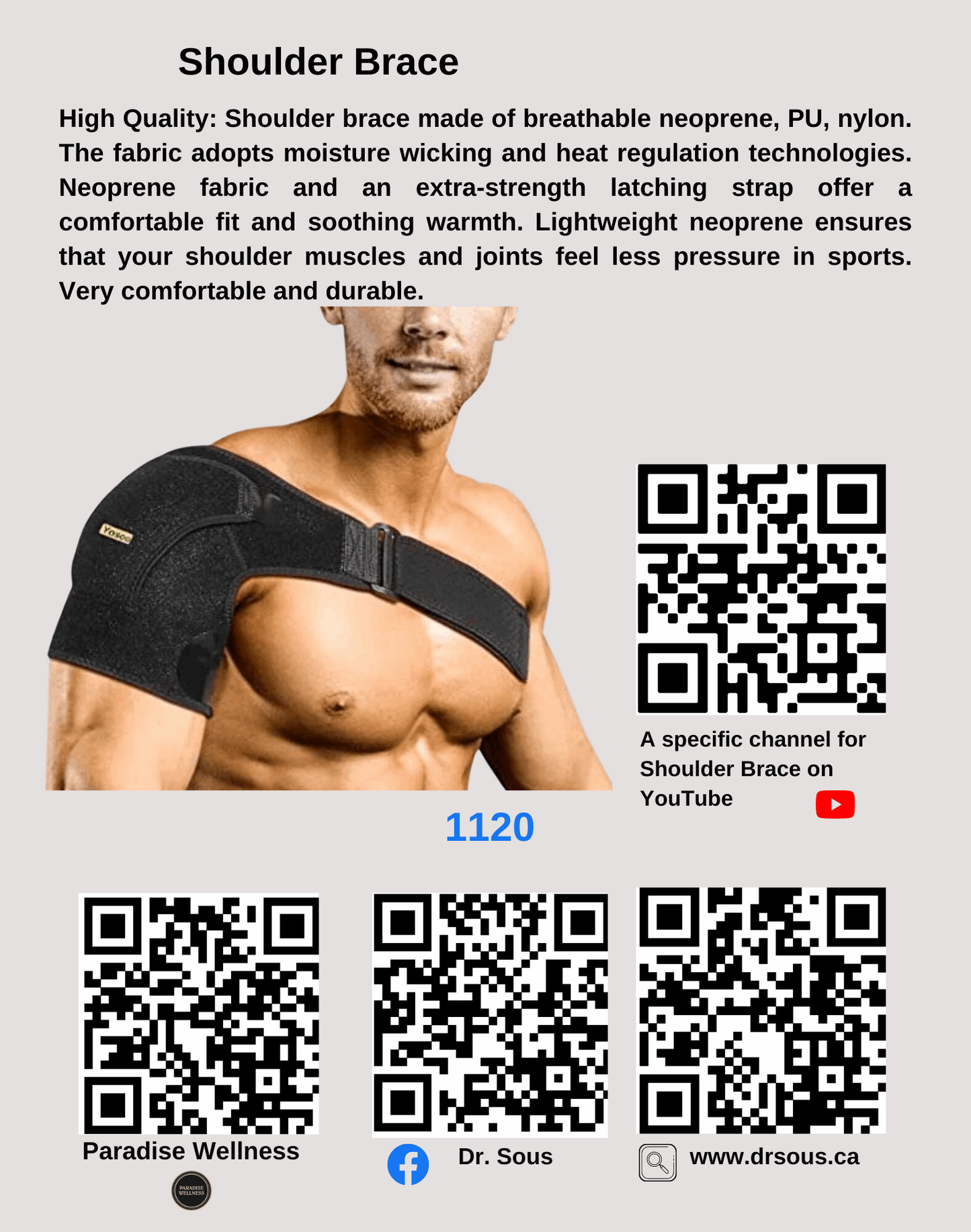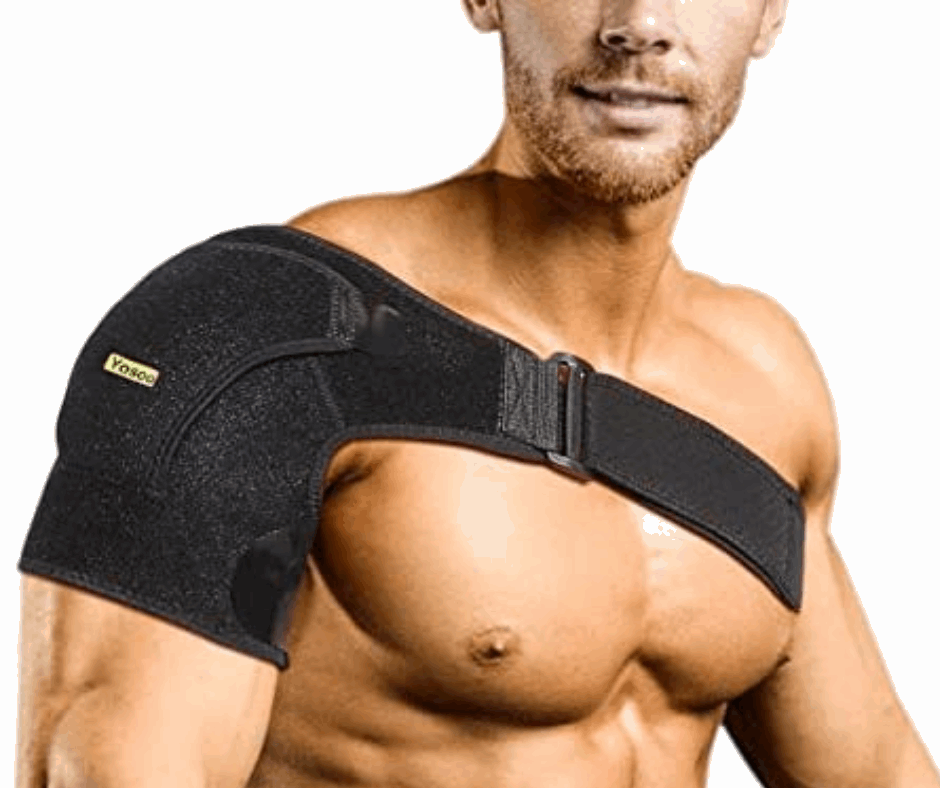1120. Shoulder Brace
1120. Shoulder Brace
Couldn't load pickup availability
DrSous.Ca
Shoulder Brace
|
Size |
L25, XL 25 |
|
Age range (description) |
Adult |
|
Colour |
Black |
|
Material |
Nylon, Neoprene, Plastic |
About this item
High Quality: Shoulder brace made of breathable neoprene, PU, nylon. The fabric adopts moisture wicking and heat regulation technologies. Neoprene fabric and an extra-strength latching strap offer a comfortable fit and soothing warmth. Lightweight neoprene ensures that your shoulder muscles and joints feel less pressure in sports. Very comfortable and durable.
Great Design: Our shoulder brace can be used for both RIGHT and LEFT shoulder, easily adjustable, strong velcro straps and high quality plastic buckle design for adjusting on right or left shoulder, support to be fit on your shoulder, users can adjust the length in accordance with individual demands, both suit for men and women. Chest adjustment ( adapts to chest measurements from 31''-55'' ), underarm adjustment ( fits arm circumference from 9''-17'' ).
Strong Protection: Our shoulder brace provide stronger, more reliable support, speed up the recovery process, to protect shoulder from injuries when playing basketball, volleyball and other sports. Reduce muscle strain, from a slight discomfort to more serious conditions like Dislocated AC Joint, Bursitis, Rotator Cuff, Labrum Tear, Frozen Shoulder Pain, Sprain, Soreness, Tendonitis, our shoulder sleeve will improve your condition and accelerate healing process.
Compression Therapy: The breathable shoulder support provides gentle compression to the shoulder, helping to increase blood flow and reduce recovery time. Timely treatment shoulder tendonitis early enough, conservative (non-surgical) treatment is usually successful for addressing your condition. Some basic home remedies you can follow such as: Rest, Ice and Posture. With a pressure pad part design for ice/heat pack (NOTE: not include ice pack).
Research Study
Shoulder injuries are common among athletes and people who engage in physical activities that involve the use of their upper body. One way to alleviate the pain and discomfort caused by shoulder injuries is by using a shoulder brace. But what exactly is a shoulder brace? In this article, we'll explore the definition of a shoulder brace, the benefits of using one, and the different types of shoulder braces available in the market and their uses. Understanding these points can help individuals make informed decisions about whether or not they need a shoulder brace and which type is best suited for their needs.
A shoulder brace is a medical device that is worn around the shoulder to provide support and stability to the joint. According to a study conducted by J. Lee et al. (2015), shoulder braces are commonly used to treat a variety of shoulder injuries such as rotator cuff tears, shoulder impingement syndrome, and shoulder instability. Shoulder braces work by limiting the range of motion of the shoulder joint, which helps to reduce pain and prevent further injury. They also help to improve proprioception, which is the ability of the body to sense the position and movement of the joints. The study conducted by J. Lee et al. (2015) found that shoulder braces can significantly reduce pain and improve shoulder function in patients with shoulder injuries. In addition to treating injuries, shoulder braces are also used by athletes to prevent shoulder injuries during sports activities. The use of a shoulder brace can help to reduce the risk of shoulder injuries by providing extra support and stability to the joint. Overall, a shoulder brace is a useful medical device that can help to treat and prevent shoulder injuries.
Shoulder injuries are common among athletes, manual laborers, and individuals with poor posture. These injuries can be debilitating and may take a long time to heal. One effective method of managing shoulder injuries is the use of a shoulder brace. According to Lavi et al. (2022), shoulder braces provide several benefits, including pain relief, improved stability, and increased range of motion. Shoulder braces work by providing external support to the shoulder joint and muscles, which reduces the strain on the injured area. This support can help to alleviate pain and promote healing. Additionally, shoulder braces can improve stability by limiting the range of motion of the shoulder joint. This can be particularly helpful for individuals with instability or dislocation of the shoulder joint. Finally, shoulder braces can help to increase range of motion by providing a controlled environment for rehabilitation exercises. Overall, the benefits of using a shoulder brace are numerous and can be an effective method of managing shoulder injuries.
Shoulder braces are medical devices that are designed to provide support and stability to the shoulder joint, and they come in different types depending on the patient's needs. According to Granstrom et al. (2007), there are three main types of shoulder braces: immobilizers, stabilizers, and rotator cuff braces. Immobilizers are used to keep the shoulder joint in a fixed position, and they are often prescribed after surgery or a serious injury to prevent further damage to the joint. Stabilizers, on the other hand, are designed to limit the range of motion of the shoulder joint while still allowing some movement. These braces are commonly used to treat conditions such as rotator cuff injuries, sprains, and strains. Finally, rotator cuff braces are specifically designed to support the rotator cuff muscles, which are responsible for stabilizing the shoulder joint. These braces are often used to treat rotator cuff tears or other injuries to the rotator cuff muscles. In conclusion, shoulder braces are medical devices that come in different types, each with its own specific use. Immobilizers are used to keep the shoulder joint in a fixed position, stabilizers are designed to limit the range of motion of the shoulder joint while still allowing some movement, and rotator cuff braces are used to support the rotator cuff muscles.
In conclusion, a shoulder brace can be a highly effective tool for individuals suffering from shoulder injuries, instability, or pain. These braces can help to provide support and stability to the shoulder joint, allowing for a faster recovery and reduced risk of further injury. Whether you are an athlete looking to prevent shoulder injuries, or someone recovering from a shoulder surgery, a shoulder brace can be an essential part of your rehabilitation process. With a wide range of styles and designs available, it is important to consult with a healthcare professional to determine the best type of shoulder brace for your specific needs. By using a shoulder brace correctly and consistently, you can help to improve your shoulder health and get back to your active lifestyle.
Work Cited
M Elboim-Gabyzon."… -Duration Electrical Stimulation with External Shoulder Support during Routine Daily Activities in Patients with Post-Hemiplegic Shoulder Subluxation: A Randomized …."https://www.mdpi.com/1766000
H Cynn."… effect of scapular posterior tilt exercise, pectoralis minor stretching, and shoulder brace on scapular alignment and muscles activity in subjects with round-shoulder …."https://www.sciencedirect.com/science/article/pii/S1050641114002235
HA Sodano."Energy harvesting from a backpack instrumented with piezoelectric shoulder straps."https://iopscience.iop.org/article/10.1088/0964-1726/16/5/036/meta
Share





